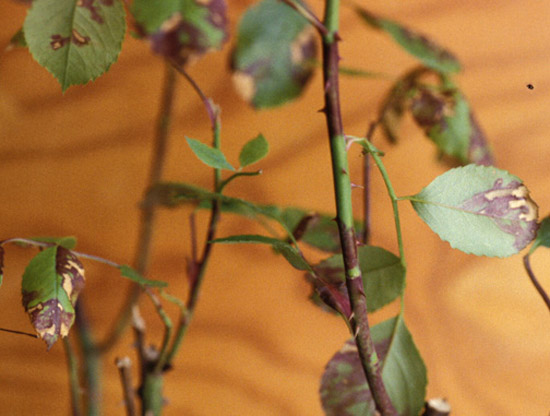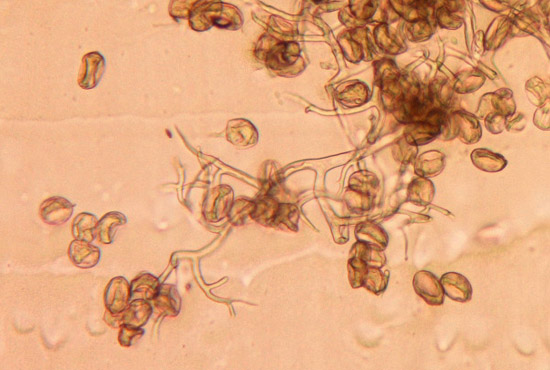Issue 5, May 21, 2010
Rose Downy Mildew
We have had a few reports of downy mildew on rose. I doubt home growers will see this problem, but it is something to watch for this spring. It is far more likely that rose downy mildew will appear in the nursery or in garden centers where roses are kept in high humidity environments or where they are watered via overhead irrigation. The effects are quite devastating, causing major leaf drop on entire rose plants.
Rose downy mildew is caused by Peronospora sparsa, a fungal-like oomycete. The pathogen thrives in cool conditions (60-70 degrees F) where the humidity is above 85%. Recent cool weather has been ideal for this pathogen.
Downy mildews can affect other ornamental hosts such as aster, coreopsis, geranium, potentilla, snapdragon, salvia, pansy, veronica and viola. The symptoms on rose, however, are more severe. Rose leaves may exhibit yellow angular blotches on the upper surface. These lesions become purplish to brown and are often accompanied by yellowing of surrounding tissues as seen in the attached image. Severe defoliation follows.

We can confirm the disease in the lab fairly quickly. The downy mildew fungus forms a downy mass of spores on the underside of leaf lesions. This downy growth is difficult to see without a hand lens or microscope, but is visible on the underside of each lesion. In many cases the downy mass of spores is visible when the sample arrives. If not, we place leaves in humidity chambers over night for easy viewing of spores the next day. An image of diagnostic conidiophores and spores viewed with a compound microscope follows.

Peronospora sparsa affects the newest growth first and spores are easily spread by wind. Since the pathogen can become systemic and will be carried in cuttings taken from infected stock, it is imperative that the disease is controlled in production areas.
There are many options listed in the 2010 Illinois Commercial Landscape and Turfgrass Pest Management Handbook as well as the Home, Yard, and Garden Pest Guide. These products are listed as preventives and work best before the disease is established. Look at the table at the end of the chapter to see a listing of fungicides, active ingredients, mobility, and company selling the product. Be sure to get thorough coverage of the foliage, especially the underside of leaves. Since the fungus will survive on infected plant parts, remove infected tissue from the site. Place tissue directly into a plastic bag and seal it before moving through the garden.
If you are confused with the difference between downy mildew and powdery mildew, consult the University of Illinois fact sheet on rose powdery mildew. That fungal disease is far less destructive. Click the following link for the downy mildew of snapdragon fact sheet.--Nancy Pataky
Author:
Nancy Pataky